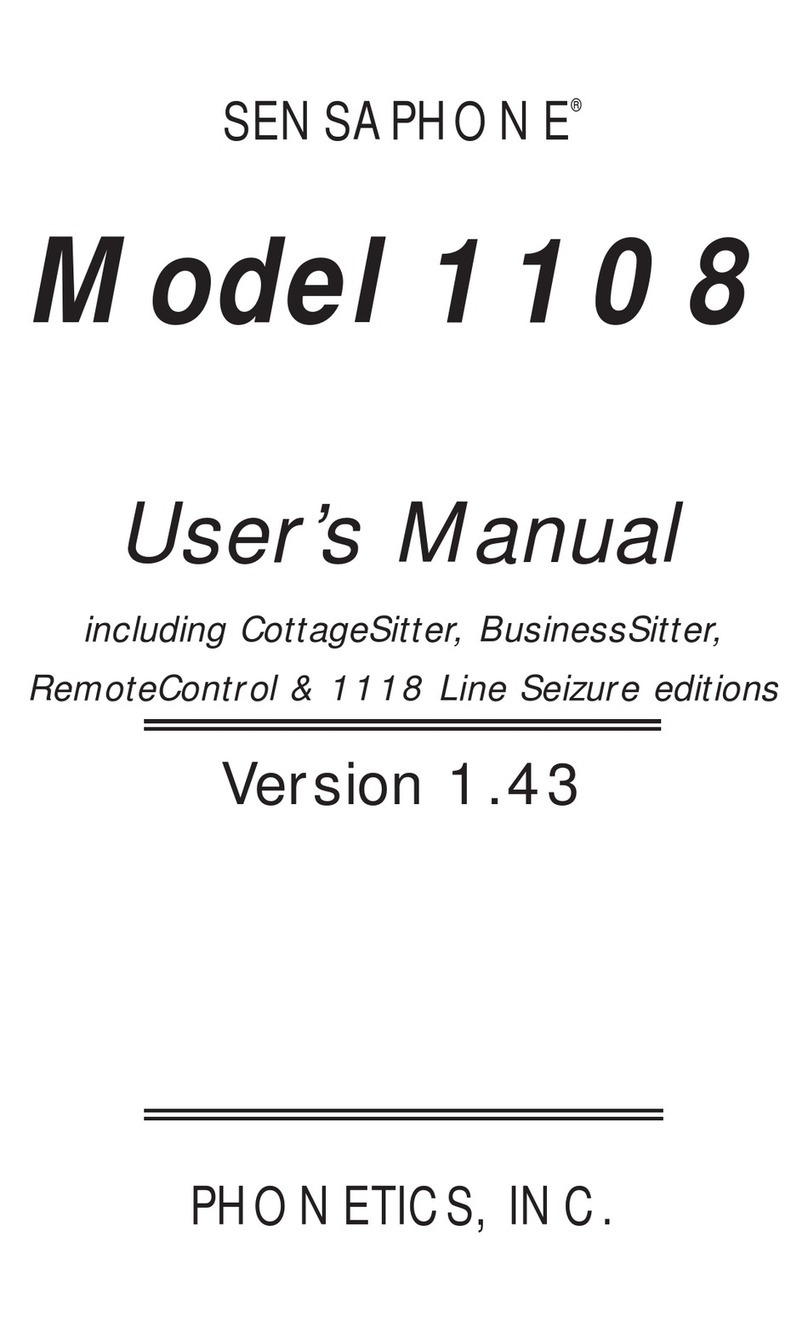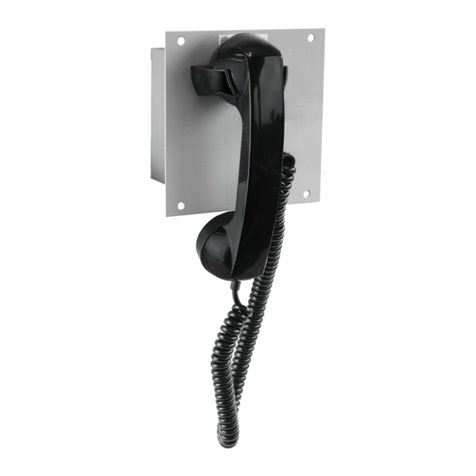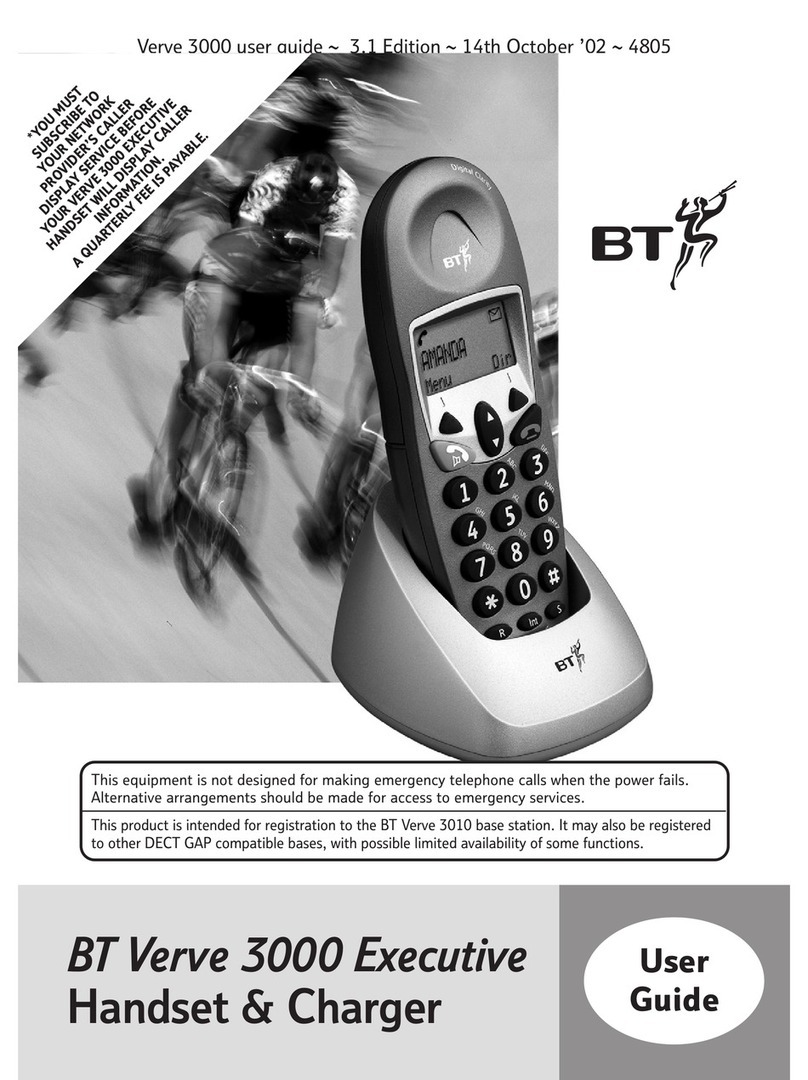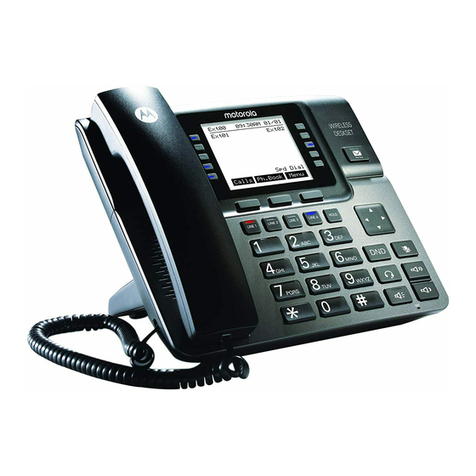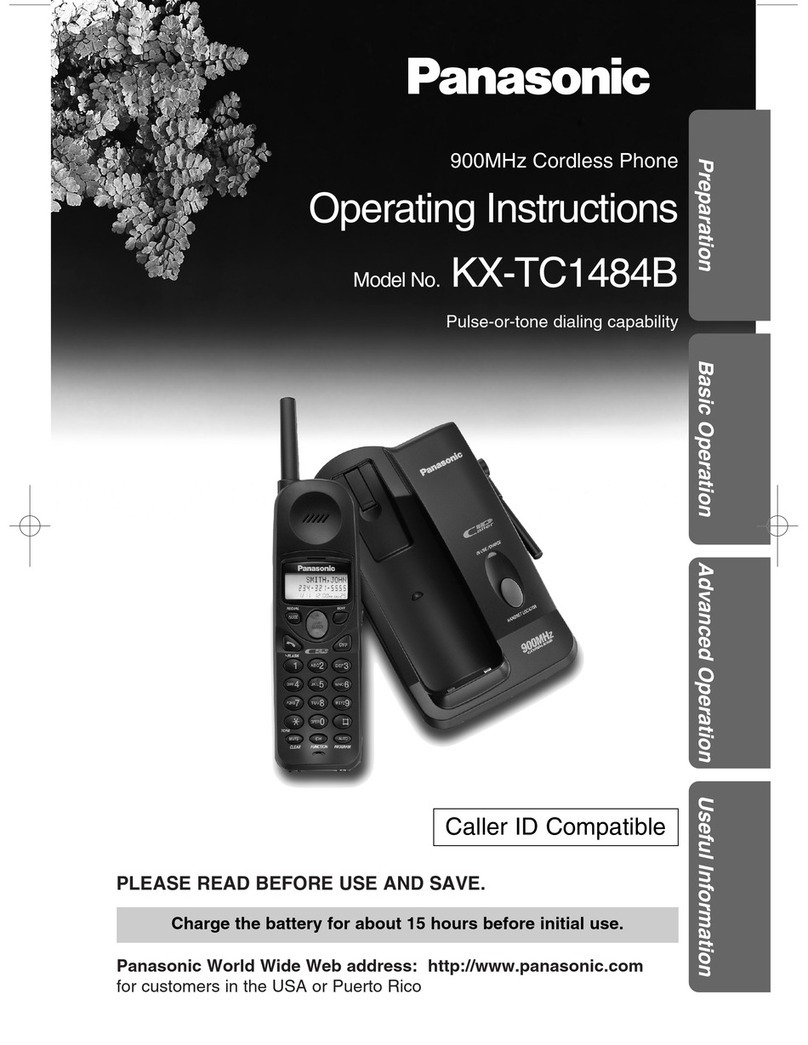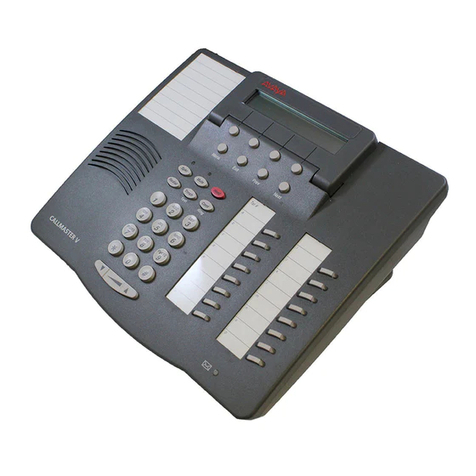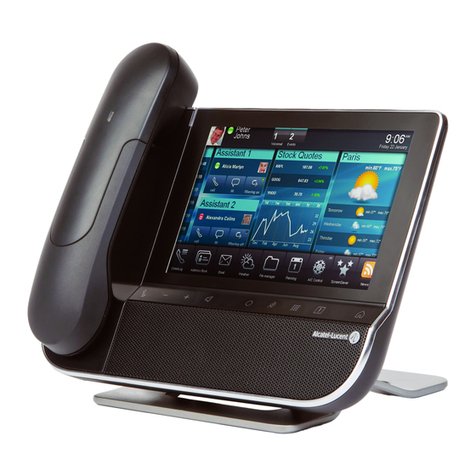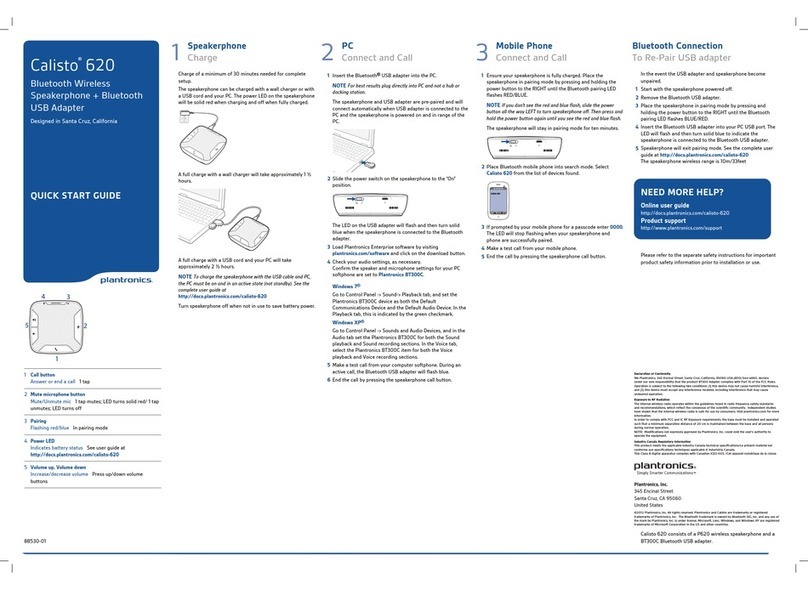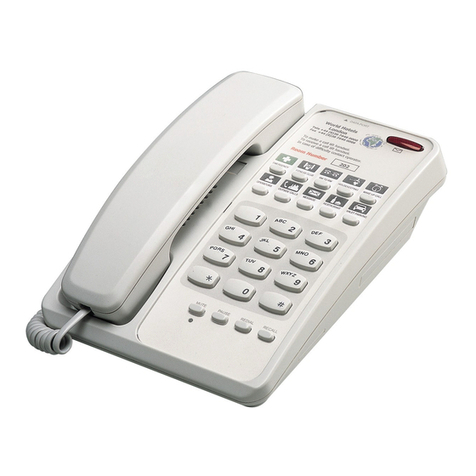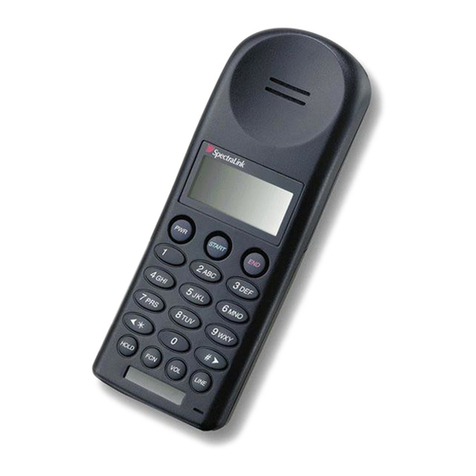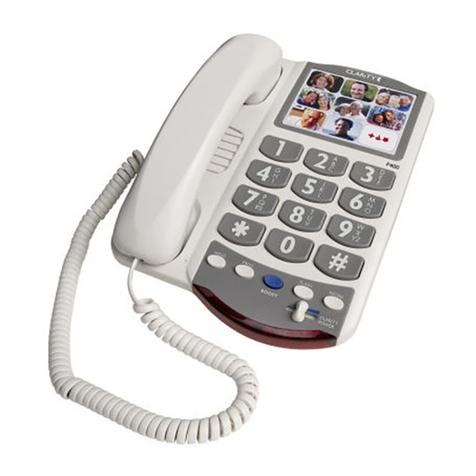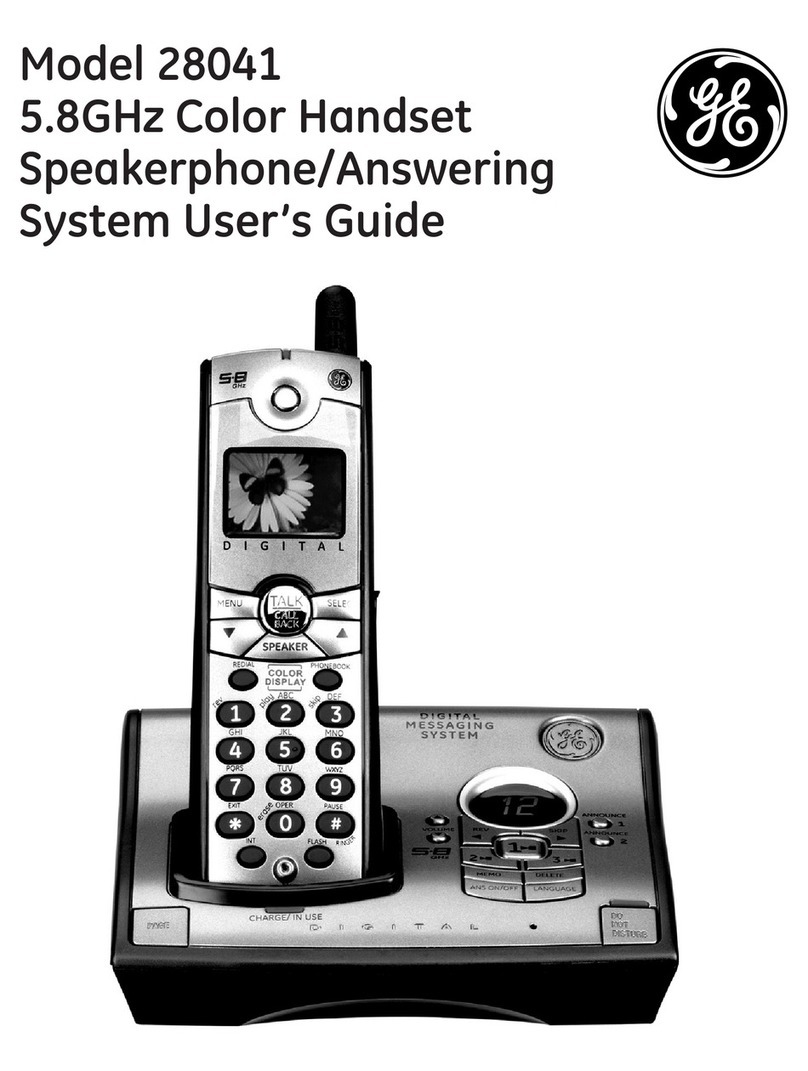Sensaphone 1104 User manual

SENSAPHONE®
Model 1104
User’s Manual
Version 1.11
SENSAPHONE, INC.

Every effort has been made to ensure that the information in this
document is complete, accurate and up-to-date. SENSAPHONE,
INC. assumes no responsibility for the results of errors beyond its
control. SENSAPHONE, INC. also cannot guarantee that changes
in equipment made by other manufacturers, and referred to in this
manual, will not affect the applicability of the information in this
manual.
© 1998 by Phonetics, Inc.
Revised Edition, version 1.11, December, 2002
Written and produced by SENSAPHONE INC. Please address all
comments on this publication to:
SENSAPHONE, INC.
901 Tryens Road
Aston, PA 19014
www.sensaphone.com
Sensaphone®is a registered trademark of Phonetics, Inc.
Touch-Tone™ is a registered trademark of AT&T.
Sensaphone®Model 1104 User’s Manual

IMPORTANT SAFETY INSTRUCTIONS
Your Model 1104 has been carefully designed to give you years of
safe, reliable performance. As with all electrical equipment,
however, there are a few basic precautions you should take to
avoid hurting yourself or damaging the unit:
• Read the installation and operating instructions in this
manual carefully. Be sure to save it for future reference.
• Read and follow all warning and instruction labels on the
product itself.
•To protect the Model 1104 from overheating, make sure all
openings on the unit are not blocked. Do not place on or
near a heat source, such as a radiator or heat register.
•Do not use your Model 1104 near water, or spill liquid of
any kind into it.
•Be certain that your power source matches the rating listed
on the AC power transformer. If you’re not sure of the type
of power supply to your facility, consult your dealer or local
power company.
•Do not allow anything to rest on the power cord. Do not
locate this product where the cord will be abused by persons
walking on it.
•Do not overload wall outlets and extension cords, as this can
result in the risk of fire or electric shock.
•Never push objects of any kind into this product through
ventilation holes as they may touch dangerous voltage points
or short out parts that could result in a risk of fire or electric
shock.
•To reduce the risk of electric shock, do not disassemble this
product, but return it to Phonetics Customer Service, or
other approved repair facility, when any service or repair
work is required. Opening or removing covers may expose
you to dangerous voltages or other risks. Incorrect
reassembly can cause electric shock when the unit is
subsequently used.
•If anything happens that indicates that your Model 1104 is
not working properly or has been damaged, unplug it
immediately and follow the procedures in Appendix C for
having it serviced. Return the unit for servicing under the
following conditions:
iii

1. The power cord or plug is frayed or damaged.
2. Liquid has been spilled into the product or it has been
exposed to water.
3. The unit has been dropped, or the cabinet is damaged.
4. The unit doesn’t function normally when you’re
following the operating instructions.
• Avoid using a telephone (other than a cordless type) during
an electrical storm. There may be a remote risk of electric
shock from lightning.
• Do not use the telephone to report a gas leak in the vicinity
of the leak.
CAUTION
To Reduce the Risk of Fire or Injury to Persons, Read and Follow
these Instructions:
1.Use only the following type and size batteries:
Alkaline, size D.
2.Do not dispose of the batteries in a fire. The cell may explode.
Check with local codes for possible special disposal
instructions.
3.Do not open or mutilate the batteries. Released electrolyte is
corrosive and may cause damage to the eyes or skin. It may be
toxic if swallowed.
4.Exercise care in handling batteries in order not to short the
battery with conducting materials such as rings, bracelets, and
keys. The battery or conductor may overheat and cause burns.
5.Do not mix old and new batteries in this product.
Sensaphone®Model 1104 User’s Manual
iv

FCC Requirements
Part 68: The Sensaphone® Model 1104 complies with Part 68 of
the FCC rules. On the back of the unit there is a label that
contains, among other information, the FCC Registration Number
and the Ringer Equivalence Number (REN) for this equipment.
You must, upon request, provide this information to your local
telephone company.
The REN is useful to determine the quantity of devices that you
may connect to your telephone line and still have all of those
devices ring when your telephone number is called. In most, but
not all areas, the sum of the REN’s of all devices connected to one
line should not exceed five (5.0). To be certain of the number of
devices that you may connect to your line, you may want to
contact your local telephone company to determine the maximum
REN for your calling area.
This equipment may not be used on coin service provided by the
telephone company. Connection to party lines is subject to state
tariffs.
Should the Model 1104 cause harm to the telephone network, the
telephone company may discontinue your service temporarily. If
possible, they will notify you in advance. But if advance notice
isn’t practical, the telephone company may temporarily
discontinue service without notice and you will be notified as
soon as possible. You will be informed of your right to file a
complaint with the FCC. The telephone company may make
changes in its facilities, equipment, operations, or procedures
where such action is reasonably required in the operation of its
business and is not inconsistent with the rules and regulations of
the FCC that could affect the proper functioning of your
equipment. If they do, you will be notified in advance to give you
an opportunity to maintain uninterrupted telephone service.
If you experience trouble with this equipment, or you need
information on obtaining service or repairs, please contact:
PHONETICS, INC.
901 Tryens Road, Aston, PA 19014
(610)558-2700 Fax: (610)558-0222
The telephone company may ask that you disconnect this
equipment from the network until the problem has been corrected
or until you are sure that the equipment is not malfunctioning.
v

Part 15: This equipment has been tested and found to comply
with the limits for a Class B digital device, pursuant to Part 15 of
the FCC Rules. These limits a designed to provide reasonable
protection against harmful interference in a residential
installation. This equipment generates, uses and can radiate radio
frequency energy and, if not installed and used in accordance with
the instructions, may cause harmful interference to radio
communications. However, there is no guarantee that interference
will not occur in a particular installation. If this equipment does
cause harmful interference to radio or television reception, which
can be determined by turning the equipment off and on, the user
is encouraged to try to correct the interference by one or more of
the following measures:
•Reorient or relocate the receiving antenna.
•Increase the separation between the equipment and the
receiver.
•Connect the equipment into an outlet on a circuit different
from that to which the receiver is connected.
• Consult the dealer or an experienced radio/television
technician for help.
Sensaphone®Model 1104 User’s Manual
vi

Canadian Department of Communications Statement
Notice: The Canadian Department of Communications label
identifies certified equipment. This certification means that the
equipment meets certain telecommunications network protective
operational and safety requirements. The Department does not
guarantee the equipment will operate to the user’s satisfaction.
Before installing this equipment, users should ensure that it is
permissible to be connected to the facilities of the local
telecommunications company. The equipment must also be
installed using an acceptable method of connection. In some
cases, where the company’s inside wiring is associated with a
single line, individual service may be extended by means of a
certified connector assembly (telephone extension cord). The
customer should be aware that compliance with the above
conditions may not prevent degradation of service in some
situations.
Repairs to certified equipment should be made by an authorized
Canadian maintenance facility designated by the supplier. Any
repairs or alterations made by the user to this equipment, or
equipment malfunctions, may give the telecommunications
company cause to request the user to disconnect the equipment.
Users should ensure for their own protection that the electrical
ground connections of the power utility telephone lines and
internal metallic water pipe system, if present, are connected
together. This precaution may be particularly important in rural
areas.
CAUTION: Users should not attempt to make such connections
themselves, but should contact the appropriate electric inspection
authority, or electrician, as appropriate.
The Load Number (LN) assigned to each terminal device denotes
the percentage of the total load to be connected to a telephone
loop which is used by the device to prevent overloading. The
termination on loop may consist of any combination of devices
subject only to the requirement that the total of the Load Numbers
of all the devices does not exceed 100. For the Sensaphone®
Model 1104, the Load Number is 8.
vii

Sensaphone®Model 1104 User’s Manual
viii

IMPORTANT SAFETY INSTRUCTIONS . . . .iii
Chapter 1: Introduction . . . . . . . . . . . . . . . .13
Technical Support . . . . . . . . . . . . . . . . . . . . . . . . . . . . .14
Chapter 2: Installation . . . . . . . . . . . . . . . . .15
2.1 Operating Environment . . . . . . . . . . . . . . .15
2.2 Mounting . . . . . . . . . . . . . . . . . . . . . . . . . .15
2.3 Power Surge Protection . . . . . . . . . . . . . . .16
2.4 Power Supply and Battery Backup . . . . . .16
2.5 Starting the Model 1104 . . . . . . . . . . . . . . .17
2.6 Run Mode and Standby Mode . . . . . . . . . .17
2.7 Telephone Line . . . . . . . . . . . . . . . . . . . . . .18
2.8 The Microphone . . . . . . . . . . . . . . . . . . . . .19
2.9 Alert Inputs . . . . . . . . . . . . . . . . . . . . . . . .19
2.10 Installing the Sensor . . . . . . . . . . . . . . . . .20
2.11 Multiple Sensors . . . . . . . . . . . . . . . . . . . .21
2.12 Outdoor Wiring . . . . . . . . . . . . . . . . . . . . . .22
2.13 Disconnecting the Model 1104 for
Storage or Seasonal Use . . . . . . . . . . . . . .23
Chapter 3: Quick Start . . . . . . . . . . . . . . . .25
3.1 The Local Keypad . . . . . . . . . . . . . . . . . . .25
3.2 Preparation for Programming . . . . . . . . . .25
3.3 Quick-Start Programming Steps . . . . . . . .26
Step 1: Set Configuration of Inputs . . . . . . . . . . . . . . . .26
Step 2: Set the ID Number . . . . . . . . . . . . . . . . . . . . .27
Step 3: Set Dial-Out Telephone Numbers . . . . . . . . . .28
Step 4: Set Temperature Limits . . . . . . . . . . . . . . . . . .29
3.4 Summary of the Alarm Dial-Out Process . .32
ix

Chapter 4: Communications Programming 33
4.1 The Unit ID Number . . . . . . . . . . . . . . . . . .33
4.1.1 Programming the ID Number . . . . . . . . . . . . . . .33
4.1.2 Interrogating the ID Number . . . . . . . . . . . . . . . .34
4.2 Dial-out Telephone Numbers . . . . . . . . . . .35
4.2.1 Programming Dial-out Telephone Numbers . . . . .35
4.2.2 Interrogating a Dial-out Telephone Number . . . . .36
4.2.3 Erasing a Telephone Number . . . . . . . . . . . . . . .36
4.3 Tone or Pulse Dialing . . . . . . . . . . . . . . . . .38
4.4 Special Dialing . . . . . . . . . . . . . . . . . . . . . .38
4.4.1 Special Dialing Keys . . . . . . . . . . . . . . . . . . . . . .38
4.4.2 Incorporating a Pause . . . . . . . . . . . . . . . . . . . .39
4.4.3 Incorporating a Pound (#) or Asterisk (*) . . . . . . .40
4.4.4 Special Dialing to a Beeper or Pager . . . . . . . . . .42
4.5 Rings Until Answer . . . . . . . . . . . . . . . . . .44
4.5.1 Programming Rings Until Answer . . . . . . . . . . . .44
4.5.2 Interrogating Rings Until Answer . . . . . . . . . . . . .44
4.6 TAD (Telephone Answering Device) . . . . .45
4.6.1 TAD Enable/Disable . . . . . . . . . . . . . . . . . . . . . .45
4.6.2 Using the TAD Feature . . . . . . . . . . . . . . . . . . . .45
4.6.3 No TAD In Use . . . . . . . . . . . . . . . . . . . . . . . . . .46
4.7 Listen-in Time . . . . . . . . . . . . . . . . . . . . . . .47
4.7.1 Programming the Listen-in Time . . . . . . . . . . . . .47
4.7.2 Interrogating the Listen-in Time . . . . . . . . . . . . . .48
4.8 Call Delay . . . . . . . . . . . . . . . . . . . . . . . . . . . . . .49
4.8.1 Programming the Call Delay . . . . . . . . . . . . . . . .49
4.8.2 Interrogating Call Delay . . . . . . . . . . . . . . . . . . . .50
4.9 Local Voice Mute . . . . . . . . . . . . . . . . . . . . . . . .51
4.9.1 Enable/Disable Local Voice Mute . . . . . . . . . . . .51
4.10 Voice Repetitions . . . . . . . . . . . . . . . . . . . .52
4.10.1 Programming Voice Repetitions . . . . . . . . . . . . .52
4.10.2 Interrogating Voice Repetitions . . . . . . . . . . . . . .52
4.11 Intercall Time . . . . . . . . . . . . . . . . . . . . . . .54
4.11.1 Programming Intercall Time . . . . . . . . . . . . . . . .54
4.11.2 Interrogating Intercall Time . . . . . . . . . . . . . . . . .55
4.12 Maximum Number of Calls (Max Calls) . . .56
4.12.1 Programming Max Calls . . . . . . . . . . . . . . . . . . .56
4.12.2 Interrogating Max Calls . . . . . . . . . . . . . . . . . . . .57
x

4.13 The Clock . . . . . . . . . . . . . . . . . . . . . . . . . .58
4.13.1 Setting the Clock . . . . . . . . . . . . . . . . . . . . . . . .58
4.13.2 Interrogating for the Current Time . . . . . . . . . . . .59
4.14 The Security Code . . . . . . . . . . . . . . . . . . .60
4.14.1 Locking the Keypad . . . . . . . . . . . . . . . . . . . . . .60
4.14.2 Unlocking the Keypad . . . . . . . . . . . . . . . . . . . . .60
Chapter 5: Alarm Programming . . . . . . . . .63
5.1 Input Configuration . . . . . . . . . . . . . . . . . .63
5.1.1 Programming Input Configuration . . . . . . . . . . . .64
5.1.2 Verifying Input Configuration . . . . . . . . . . . . . . . .65
5.2 Enable/Disable Inputs . . . . . . . . . . . . . . . .65
5.2.1 Changing Enabled/Disabled Input Status . . . . . . .65
5.2.2 Verifying Enabled/Disabled Input Status . . . . . . .65
5.3 Input Recognition Time . . . . . . . . . . . . . . .66
5.3.1 Programming Input Recognition Time . . . . . . . . .66
5.3.2 Interrogating Input Recognition Time . . . . . . . . . .67
5.4 Establishing High and Low
Temperature Limits . . . . . . . . . . . . . . . . . .69
5.4.1 Programming Temperature Limits
for a Selected Input . . . . . . . . . . . . . . . . . . . . . . .69
5.4.2 Disabling Alarm Response to High or Low
Temperature . . . . . . . . . . . . . . . . . . . . . . . . . . . .70
5.4.3Interrogating High and Low Temperature Limits . . .70
5.5 Temperature Scale . . . . . . . . . . . . . . . . . . .71
5.6 Temperature Calibration . . . . . . . . . . . . . . . . . . .71
5.6.1 Programming Temperature Calibration . . . . . . . .72
5.6.2 Interrogating Temperature Calibration . . . . . . . . .72
5.7 Obtaining Current Temperature . . . . . . . . .73
5.8 AC Power Monitoring Enable/Disable . . . .74
5.8.1 Enabling/Disabling the AC Power Alarm . . . . . . .74
5.9 AC Power Failure RecognitionTime . . . . .74
5.9.1 Programming Power Failure Recognition Time . .75
5.9.2 Interrogating Power Failure Recognition Time . . .76
5.10 Sound Alarm Monitoring . . . . . . . . . . . . . .77
5.10.1 Programming Sound Alarm Sensitivity . . . . . . . .77
5.10.2 Interrogating Sound Sensitivity . . . . . . . . . . . . . .78
xi

5.10.3 Programming High Sound Alarm
Recognition Time . . . . . . . . . . . . . . . . . . . . . . . .78
5.11 High Sound Alarm Enable/Disable . . . . . .79
5.11.1 Changing Enabled/Disabled High Sound Alarm . . . .79
5.12 Exit Delay . . . . . . . . . . . . . . . . . . . . . . . . . .80
Chapter 6: Acknowledgment, Status
Report & Remote Access . . . . .81
6.1 Alarm Acknowledgment . . . . . . . . . . . . . . .81
6.1.1 Local Acknowledgment . . . . . . . . . . . . . . . . . . . .81
6.1.2 Touch-Tone™ Acknowledgment . . . . . . . . . . . . .81
6.1.3 Callback Acknowledgment . . . . . . . . . . . . . . . . .82
6.2 Status Report . . . . . . . . . . . . . . . . . . . . . . .83
6.2.1 Example: Status Report, No Alarms . . . . . . . . . .83
6.2.2 Example: Status Report, Existing Alarms . . . . . .84
6.2.3 Example: Status Report, Disabled Inputs . . . . . .85
6.2.4 Battery Condition . . . . . . . . . . . . . . . . . . . . . . . .85
6.2.5 Remote Access by Touch-Tone™ Telephone . . . .86
Chapter 7: Operation . . . . . . . . . . . . . . . . .89
7.1 Alarm Detection, Dial-out and
Acknowledgment . . . . . . . . . . . . . . . . . . . .89
7.2 Example: A Dial-out Telephone Call . . . . .94
Appendix A: Troubleshooting . . . . . . . . . .95
Appendix B: Checking your Sensaphone
for Proper Operation . . . . . .103
Appendix C: Accessories . . . . . . . . . . . . .105
Appendix D: Returning the Unit
for Repair . . . . . . . . . . . . . . .107
Warranty . . . . . . . . . . . . . . . . . . . . . . . . . . .108
xii

Chapter 1: Introduction
The Sensaphone®Model 1104 is a fully-programmable,
environmental monitoring system that offers extensive on-site and
remote monitoring capability to small businesses, private homes,
farms, greenhouses, computer rooms, and remote facilities.
Designed for desktop or wall mounting, the Model 1104 is simple
to install, program and operate; no changes to standard electrical
or telephone service are required. Connected to a telephone line,
it will respond to an alarm by dialing up to four separate
telephone numbers. When the call is answered, an “Alert
Condition” message is delivered in digitized speech.
The Model 1104 features built-in sensors to monitor a variety of
conditions:
• High sound level
•AC electric power failure
• Battery backup
• Temperature*
*Note: While technically not a “built-in” sensor, tem-
perature is factory installed on input 1, and if left
installed will limit your additional inputs as listed
below to 3.
1104 is equipped with 4 alert inputs. Additional sensors* can be
added to extend monitoring capabilities to include:
•Intrusion or unauthorized entry
•Water leaks and seepage
•Temperature
• Humidity
•Equipment operation
•Many other conditions that may require unique monitoring
solutions
* Refer to Appendix B for information on additional
sensors (available separately from Sensaphone) best
suited to your application.
The status of each monitored condition is readily obtained at the
unit's installation site, or remotely by telephone. At the close of
every Status Report, time is provided for listening to on-site
sounds.
13

To ensure reliable operation, the Model 1104 features power
backup capability; in the event of AC power failure, six D-cell
batteries (not included) will continue to power the unit for
approximately 24 hours.
This manual comprises the instructions and commands for
installing and operating the Model 1104. The Quick Start chapter
is included to speed understanding of programming and operation.
Communication and Alarm Programming chapters demonstrate
step-by-step methods for utilizing the full range of available
features. The Troubleshooting chapter provides assistance in the
event that problems are encountered.
Technical Support
If any questions arise upon installation or operation of the Model
1104, please contact Sensaphone Technical Service Department,
at the number shown below, and have the following information:
• Date of Purchase _______________
• Serial number of your Model 1104 _________________
Technical Support is available from 8:00 am to 5:00 pm EST.
Sensaphone, Inc.
901 Tryens Road
Aston, PA 19014
(610)558-2700
Fax: (610)558-0222
www.sensaphone.com
Sensaphone®Model 1104 User’s Manual
14

Chapter 2: Installation
Correctly installing the Model 1104 will ensure proper
functioning of the unit. Please read the entire chapter before
starting the installation process.
Within the packaging will be a Warranty Registration Card.
Please take the time to fill this out and mail. The OneYear
Limited Warranty is explained in the back of this manual.
2.1 Operating Environment
The Model 1104 should be installed and operated in an area that
provides space for wiring sensors to the screw terminals, near an
AC power source and telephone line. Operating temperature
ranges from 32° Fahrenheit (0° Celsius) to +120° Fahrenheit
(+49° Celsius).
NOTE
The Model 1104 is a sensitive electronic device. Do
not install the Model 1104 near strong electrostatic,
electromagnetic or radioactive fields. Do not expose
to fumes or corrosive vapors.
2.2 Mounting
Flat Mount: Place the Model 1104 on top of a desk or other
horizontal surface. Wall Mount: Mount on a wall with two screws
using the keyholes on the back panel of the unit. Place the screws
or bolts 313/16" apart at the desired height from the floor. Hook
the unit over the screws and toward the floor. Refer to Figure 2-1.
Figure 2-1. Wall Mount
313 16"
15

2.3 Power Surge Protection
The Model 1104 can be damaged by power surges and lightning
through the telephone line and the 120 VAC power supply.
Although the Model 1104 has built-in surge protection, we
recommend that additional protection be obtained for the unit and
for any electronic equipment that is attached to your power supply
and telephone lines. Power surge protection is especially
important if you live in a lightning-prone area. The ISOTEL
Surge Protector Model IB-4 is available through Sensaphone, Inc.
See Appendix B.
2.4 Power Supply and Battery Backup
The Model 1104 is provided with an AC power transformer that
will plug into any standard 120 VAC outlet and a battery backup
(batteries not included) that enables the unit to continue
functioning if AC power is removed (due to electric power
disruption or failure). The Model 1104 uses six, D-cell alkaline
batteries. Do not use rechargeable nicad batteries.
NOTE
Be sure that the AC transformer is plugged into an
outlet before installing batteries.
To install the batteries, open the battery compartment hatch
located underneath the unit, align batteries according to the
diagram shown in Figure 2-2, and replace the hatch.
Figure 2-2. Battery Installation
---
---
+++
+++
Sensaphone®Model 1104 User’s Manual
16

2.5 Starting the Model 1104
When the AC power transformer is first plugged into the electrical
outlet, the Model 1104 automatically starts in RUN mode. The
red LED light will begin to glow. The unit will respond
with,“Hello, this is Sensaphone® 1104.”
2.6 Run Mode and Standby Mode
Pressing the RUN/STANDBY key on the Model 1104 keypad will
alternately activate or deactivate the unit. If the unit is activated
and in RUN mode, the red LED (small red light on the upper right
of the unit’s front panel) glows steadily. In STANDBY mode, the
red LED goes out, but will blink every few seconds to indicate
that power is still supplied to the unit.
In RUN mode, the Model 1104 is able to receive incoming calls
and to dial out automatically in the event of an alarm on one of
the monitored conditions. To enter STANDBY mode, press
RUN/STANDBY.
As soon as the Model 1104 enters STANDBY mode, it responds
with “Have a good day.” The red light immediately goes out and
then resumes with a blink every few seconds. While in
STANDBY mode, all functions are disabled, but programmed
memory is preserved. Upon exiting STANDBY mode, any
currently existing alert conditions will be announced.
NOTE
STANDBY mode is not equivalent to “power off”—
an electrical source, such as the 120 VAC, or the bat-
tery backup, continues to provide full power to the
unit. If the unit is placed in STANDBY mode,
unplugged from the 120 VAC outlet, and placed in
storage, the batteries will continue to power the
Model 1104, discharging until they fail.
Consequently, batteries should always be removed
from the unit following disconnection from any 120
VAC outlet, prior to storage.
Press the RUN/STANDBY key again to return to RUN mode.
Figure 2-3. The RUN/STANDBY Key
RUN
STANDBY
Chapter 2: Installation
17

2.7 Telephone Line
The Model 1104 will operate with all standard telephone systems
that accept pulse or tone dialing. The Model 1104 cannot be used
on an extension line to dial its own telephone number. Also, it
may not be installed on a party line or pay telephone line.
Certain private telephone systems and public switching equipment
may not accept the Model 1104 dialing or may generate an
unacceptable ring signal. In those cases, a dedicated line may be
required. Consult the supplier of your telephone system if you
encounter problems.
If you do not have a modular telephone extension at the Model
1104’s location, you must contact your local telephone company
to have one installed (there is a charge for this service). If you
have four-pin jacks, adapters are available to convert them to the
modular plugs. Contact your local telephone company or
electronics parts store.
CAUTION
Never install telephone wiring during a lightning
storm. Never install telephone jacks in wet locations
unless the jack is specifically designed for wet loca-
tions. Never touch uninsulated telephone wires or ter-
minals unless the telephone line has been disconnect-
ed at the network interface. Use caution when
installing or modifying telephone lines.
To install the telephone line, plug the modular telephone jack
provided into any standard RJ11 phone outlet.
Refer to Figure 2-4.
Figure 2-4. Installing the Telephone Line
On the back of the Model 1104 is a female telephone jack. This
is provided so that a telephone or other answering device may be
used on the same line as the unit. It is not necessary to hook up a
telephone for the Model 1104 to operate.
2341
GND GND GNDGND
AC Power
Transformer
(plug into
120 VAC outlet)
RJ11 Outlet
(for modular
telephone jack) Modular Telephone Jack
(plug into RJ11 outlet)
Female Telephone Jack
(connect telephone here)
Sensaphone®Model 1104 User’s Manual
18

2.8 The Microphone
The Model 1104 is provided with a built-in microphone which is
used to monitor high sound levels produced near the installation
site. The sensitivity of the microphone is configurable and will
detect a continuous as well as a beeping alarm.
Other programming options that apply to the microphone include
setting the length of time before a high sound causes an alarm.
If this sound level exists for 8 consecutive seconds (default) or for
the programmed length of time, the Model 1104 will dial out with
an alarm message.
NOTE
The proximity of the audible alarm to the microphone
is extremely important.
Normally, the Model 1104 and the audible alarm must be in the
same room. The maximum distance can vary considerably
depending on the alarm, the acoustics, and the size of the room.
During an alarm dial-out, the microphone allows four-second
intervals to listen-in to sounds at the Model 1104’s location.
When calling for a Status Report, the microphone permits
listening to on-site sounds for a programmed time interval.
2.9 Alert Inputs
The Model 1104 can monitor up to 4 inputs (represented by the
numbered terminal screws shown in Figure 2-5, below).
Figure 2-5. Alert Inputs
Inputs are configured as either dry contact or temperature. An
input configured as dry contact can be used with any normally
open (N.O.) or normally closed (N.C.) device. “Open” refers to
an opened circuit path; if conditions cause the circuit to close, an
alert condition occurs. “Closed” refers to a continuous circuit
path; if a closed circuit is opened, an alert condition occurs. The
Model 1104 determines the way inputs are configured by the type
2341
GND GND GNDGND
Chapter 2: Installation
19

of sensor connected to each alert input (refer to Chapter 5,
Section 5.1).
An input configured as “temperature” is designed to evaluate a
range of settings. The Model 1104 will read the temperature at the
sensor’s location and compare that value to programmed high and
low temperature limits. Temperature inputs must be used with
Phonetics Remote Temperature Sensor.
NOTE
Before wiring, it is advisable to disable the inputs to
prevent accidentally tripping an alarm. See Chapter 5,
Section 5.2.
2.10 Installing the Sensor
After you have selected the sensor, loosen the screw of the alert
input and its corresponding ground. Two wire leads are used to
connect any monitoring sensor. Fasten one lead to the numbered
screw and the other lead to GND. Tighten both screws. If the
input was not disabled, the Model 1104 may recite its “Alert
Condition Exists” message as you connect the sensor. If it does,
just press any key to stop it. Re-enable the input after wiring.
Refer to Figures 2-6 and 2-7 for connecting a sensor to an alert
input.
Figure 2-6. Sensor Connected to an Alert Input
Any sensor can be attached to the Model 1104 using 22-gauge
wire. The sensor can be several hundred feet from the unit, as
long as the total resistance of the circuit is not greater than 50
ohms. Use wire appropriate for the application.
2341
GND GND GNDGND
Sensor wired to
Alert Input 3
Sensaphone®Model 1104 User’s Manual
20
Other manuals for 1104
3
Table of contents
Other Sensaphone Telephone manuals

